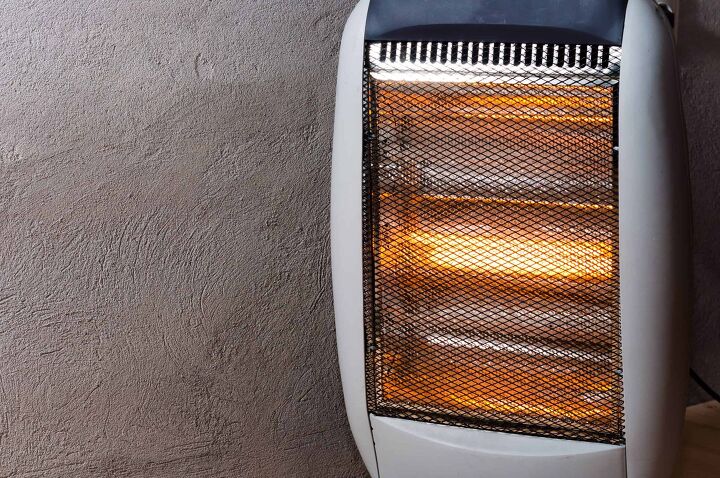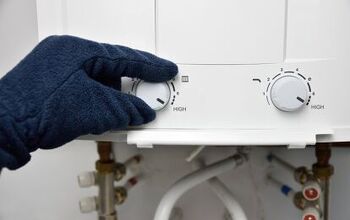How Much Propane Does A 30,000 BTU Heater Use?

A propane heater is a valuable and versatile investment that can heat your house or warm your mobile home or camper. Also, it can operate in a power outage, making it a boon during emergencies or natural disasters. But, you need to make sure you have enough propane, so how much propane does a 30,000 BTU heater use?
A 30,000 BTU heater requires one gallon of propane for every three hours. Therefore, if you continuously run your heater, you’ll consume 1/3 gallon of propane per hour. If your heater had 33,000 BTUs, you’d use approximately one gallon of propane per hour. A 100lb propane tank would give you roughly 72 hours of burn time. A 500lb tank would provide roughly 358 hours of burn time.
Several formulas can help estimate the amount and cost of fuel you need to run an appliance. But first, we need to know what units of energy we’re talking about.
Do You Need Gas Furnace or Forced Air Heating System Installers?
Get free, zero-commitment quotes from pro contractors near you.

BTUs And Megajoules
BTU stands for British Thermal Unit. It’s a globally recognized energy unit and the most common way to measure heat energy in the USA. A BTU is the amount of energy required to heat one pound of water by one degree Fahrenheit.
A megajoule (MJ) is the metric unit used to measure heat energy. One megajoule is equal to 1,000,000 joules. A joule is the force it takes to move one newton the distance of one meter.
One MJ is equal to 947.82 BTUs. BTUs are most commonly used in the United States to rate heat-producing appliances and calculate the cost of heating fuels. In some cases, however, it’s helpful to convert one unit to another for easier comparison.
Doing The Math
Calculating Propane Gas Consumption
To calculate how much propane an appliance will consume per hour, follow these steps:
- Identify the BTU or MJ rating of the appliance. This number indicates the amount of energy consumed per hour, not how much it puts out. You can find this information in the owner’s manual.
- Note the energy content of the fuel. For propane, that’s 91,500 BTUs per gallon, per hour.
- Divide the energy content by the consumption rating of the appliance. Let’s take our 30,000 BTU heater, for example. 91,500 divided by 30,000 equals 3.05 hours.
So, one gallon of propane fuel will power a 30,000 BTU heater for about three hours.
From there, you can figure out how many hours a day, week, or month you might use the heater. Take into account times when you’re out of the house and don’t need heat or overnight when the temperature may drop. Using this formula, you can create an accurate estimate of how much propane gas you need to power your wall-mounted heater.
Calculating The Cost
The next step is to figure out the cost. Continuing with our last example, let’s say we’ll be running the heater for eight hours a day. If we want to find the cost for the month, let’s multiply those eight hours by 30 days for a total of 240 hours.
The cost to operate a propane wall heater is about $0.80 per hour. So, if we multiply that price by our total of 240 hours, we can estimate spending $192 on propane heating fuel that month.
Believe it or not, propane heat is more economical than electricity. Nearly everything in your home that runs on electricity, from the lights to your appliances, can also run on propane.
In fact, the cost to heat a propane-fueled home is much less than a home heated by electric heat. According to the U.S. Department of Energy, the cost of electricity is twice the amount of propane.
Propane Wall Heaters
Many propane heaters are small, wall-mounted appliances. A 30,000 BTU model costs around $200, while a 10,000 BTU unit sells for about $100. They are efficient, space-saving devices that produce high heat to warm up rooms quickly.
Vented Versus Ventless
There are two types of propane wall heaters: vented and ventless. The vented models carry exhaust air outside, while the ventless ones have no such ductwork.
People consider vented propane heaters safer since they divert potentially harmful fumes and noxious gases outside the home. They also use a substantial amount of heat through their ducts, making them less efficient. Burning that extra fuel is bad news for both your wallet and the environment.
However, ventless propane heaters are much easier to install than vented ones. You can place ventless heaters anywhere along the wall you deem safe and where you can mount them easily. They’re also known to warm up a room faster and more efficiently than vented heater models.
Vented heaters, on the other hand, are much more invasive. If you have an existing duct for exhaust ventilation, you must place the heater near that location. If not, you’ll need to open up a wall and run a duct between the wall joists and ceiling beams.
How To Install A Propane Wall Heater
- Choose the best location for your heater. You should install these types of heaters near the bottom of a wall. This placement allows the heat to rise and fill the room quickly and evenly.
- Each heater comes with brackets that mount the heater to the wall. Screw the brackets into the wall, ensuring proper spacing to hang the appliance.
- Hang the heater temporarily and estimate where to drill the hole for the propane hose.
- Remove the heater and drill the hole for the propane hose.
- Return the heater to its brackets and slide the hose through the new hole to connect the heater and the propane tank.
- If installing a vented heater, connect the appliance to the appropriate duct to carry fumes to the house’s exterior.
Video: Installing A Ventless Wall Heater
Here’s a look at a basic install for a vent-free wall heater that can work with either liquid propane or natural gas.
Propane Wall Heater Safety Concerns
Several safety concerns come with the convenience of a propane wall heater. Most center around a burn or fire risk.
If small children or animals live in your house, think twice about installing a propane wall heater.Since they’re usually installed at a low wall height, they’re in perfect reach of a little one’s hand or paw. Avoid the risk of burns by keeping them out of the room or choosing another kind of heater.
Aside from the fact that propane is a flammable gas, there are other fire risks associated with propane wall heaters. New models come with overheat protection, a feature that shuts the heater off when it reaches a critically high temperature. This feature helps to prevent fires caused by a heater left unattended.
Never use an outdoor propane wall heater in an indoor space.Properly functioning heaters give off carbon dioxide as a natural byproduct. If oxygen levels drop, the heater can produce toxic carbon monoxide gas that can be deadly.
Some propane heaters feature a low-oxygen shut-off similar to the overheat protection. It’s also advisable to mount a carbon monoxide detector in each room with a propane heater. You should mount them near the baseboards since the gas sinks instead of rising.
All things considered, propane is one of the safer chemicals used for home heating. It won’t ignite in the air unless the temperature is at least 900 degrees Fahrenheit. That’s considerably higher than kerosene and diesel home heating oil, two other standard fuels.
How Much Propane To Use
With propane water heaters, the recommendations may vary in regards to how much propane you should use. With that being said, there are a number of factors that may alter that number.
For starters, the primary factor you must consider when determining how much propane to use is the outside temperature. If the outdoor climate is mild or slightly warm, you may not require as much propane.
However, when you’re operating your propane heater at full power, you are using the maximum energy that is listed for your particular heater. When you turn the heat down, you don’t use as much propane. Because of this, it’s important to turn your propane heater off when it’s not needed. Also, adjust the temperature to keep your home comfortable and your heating bills low.
How Long Will Propane Tank Last With A 30,000 BTU Heater?
To determine how much burn time you can get from your propane tank, use this simple formula. Consider one pound of propane has roughly 21,500 BTUs. Now, assume your home has a 300-pound propane tank.
Multiply the tank size in pounds by the BTUs in one pound of propane, so 21,500 x 300=6,450,000. Next, divide this number by the BTUs of your heater, in this case, 30,000. So, 6,450,000 divided by 30,000=215.
Using this formula, you can determine that your 300-pound propane tank will last for approximately 215 hours of burn time. Using this same formula, a 100-pound tank would last for about 72 hours, and a 500-pound tank would burn for about 358 hours.
What Size Propane Heater Is Best For My Space?
To fully heat a room, calculate your heater’s ideal size using a tried and true formula. This calculation is similar to how you would determine the size of a heating oil tank for your home.
The average propane heater’s capacity is 40 BTUs per square foot. For example, in a 250 square foot apartment, a 10,000 BTU heater would be sufficient.
Switching to propane gas can be an excellent investment to power your home. Installing a propane heater is a great way to save money on heating costs. All it takes is a bit of know-how and calculation. Stay warm!
Final Thoughts
A 30,000 BTU propane heater does not consume too much energy or propane while in use. After some basic calculations, you’ll be able to determine how much propane is required to operate your particular unit.
With a 30,000 BTU heater, you will need one gallon of propane every three hours. You can expect to pay an average of $200 a month, depending on how often you use it and how high you set the heat. Regardless, you’ll likely be able to save on whole-house heating costs by using a propane wall heater to warm an area.
Do You Need Gas Furnace or Forced Air Heating System Installers?
Get free, zero-commitment quotes from pro contractors near you.


Stacy Randall is a wife, mother, and freelance writer from NOLA that has always had a love for DIY projects, home organization, and making spaces beautiful. Together with her husband, she has been spending the last several years lovingly renovating her grandparent's former home, making it their own and learning a lot about life along the way.
More by Stacy Randall













![The 5 Best Angle Grinders – [2022 Reviews & Buyer's Guide]](https://cdn-fastly.upgradedhome.com/media/2023/07/31/9071326/the-5-best-angle-grinders-2022-reviews-buyer-s-guide.jpg?size=350x220)








![Cost To Drill A Well [Pricing Per Foot & Cost By State]](https://cdn-fastly.upgradedhome.com/media/2023/07/31/9074980/cost-to-drill-a-well-pricing-per-foot-cost-by-state.jpg?size=350x220)




